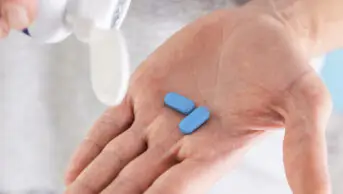
Shutterstock.com
After reading this article, you should be able to:
- Apply a systematic approach to the assessment of patients presenting with acute undifferentiated conditions;
- Use validated tools to identify patients who need referral to other healthcare professionals or who can be treated safely;
- Identify actions, including a detailed management plan and appropriate safety netting.
Introduction
Pharmacy teams are now providing advanced care to patients in several settings, with a move away from the transactional care relationship exemplified by community pharmacy1. With the publication of the NHS ‘Delivery plan for recovering access to primary care’2, the advent of the community pharmacy common minor ailment service in Wales, the Pharmacy First schemes in England3 and Scotland4, and training delivered as a result of the Pharmacy Integration Fund5, pharmacists are performing clinical roles more often.
Pharmacists are increasingly often the only clinician consulting with patients for acute conditions and minor ailments, such as those covered by the Pharmacy First programme. Although this is a welcome expansion of the pharmacist role, it brings with it additional demands and considerations. Traditionally undertaken by other healthcare professionals, physical examinations and theorising a diagnosis are now often required of the pharmacist. While newly qualified pharmacists have been taught additional clinical skills, such as enhanced consultation skills, physical examination practice and prescribing, many pharmacists who currently deliver services on the front line will not have received such training6.
This article provides an overview of what to consider when undertaking any health assessment. It is recommended that you read this article in conjunction with these resources available from The Pharmaceutical Journal:
- ‘How to use clinical reasoning in pharmacy’;
- ‘Introduction to the prescribing consultation’;
- ‘Principles of effective history taking when prescribing’;
- ‘Making consultations in community pharmacy matter’;
- ‘Writing patient notes: a guide for pharmacists’.
Adopting a structured approach to health assessment
A health assessment for a patient should adopt a systematic process that can be broken down into seven steps:
- Undertake a brief ‘general assessment’ of the patient, using validated tools;
- Take a detailed history from the patient, utilising a patient-centred approach;
- Conduct any necessary physical examinations;
- Consider other investigations, such as urinalysis, spirometry, blood tests or imaging;
- Formulate a working diagnosis;
- Create a management plan using a shared decision-making approach;
- Document findings and provide handover (where necessary).
Step 1: Undertake a brief ‘general assessment’ of the patient
General observation of the patient should be undertaken at the start of any health assessment. This general observation is usually rapid and can begin from the moment the patient first walks into the consultation room. There are several clinical tools to assist with general observation; for instance, the ‘ABCDE’ assessment tool of the deteriorating patient7–9. This mnemonic allows for the rapid assessment of a patient’s health condition and consists of the following:
- Airway status;
- Breathing pattern;
- Circulatory system status;
- Disability (possible reasons as to why they might be losing consciousness);
- Exposure (involving rapid examination of the whole body).
Most pharmacists will not have to utilise the ABCDE approach in their day-to-day practice, as they are more likely to deal with non-critically ill patients, such as those seen in primary care. Tools more useful for pharmacists assessing acute conditions include the national early warning score (NEWS, NEWS2)10 or paediatric early warning system (PEWS)11. The NEWS2 tool creates an aggregated score based on respiratory rate, oxygen saturation, systolic blood pressure, pulse rate, new confusion (or level of consciousness) and temperature to assist in the grading of illness severity and detection of patient deterioration10. The use of these tools ensures that the patient is assessed for the possibility of sepsis.
Another useful mnemonic for rapid general assessment in pharmacy consultations is ‘SOMETEAMS’, which stands for12:
- Symmetry — are the body and face symmetrical?
- Old — does the patient look their age?
- Mental acuity — is the patient alert, confused or agitated?
- Expression — does the patient appear to be ill (pale or grey), in pain or appearing anxious?
- Trunk — is the patient lean, stocky, obese or barrel-chested?
- Extremities — does the patient have visible bruising, oedema, clubbed fingers or obvious joint abnormalities?
- Appearance — is the patient clean and appropriately dressed?
- Movement — how was the patient’s posture, gait and coordination when they walked to the consultation room? How are they holding themselves while seated?
- Speech — is the patient’s speech coherent and appropriate? Do they sound stressed?
Using these tools, the clinician can broadly categorise patients into traffic light categories of red, amber and green13. Patients in the ‘green’ category often do not require treatment and rapid deterioration is deemed unlikely. Such patients are frequently given suitable safety-netting advice and signposted to self-care options, such as the NHS website and mental health apps, for example. Patients categorised as ‘amber’ are most suitable for review in primary care and may include minor ailments, Pharmacy First conditions and illnesses commonly seen in general practice. Patients categorised as ‘red’ via the ABCDE or NEWS2 approaches will probably require rapid assessment and treatment in secondary or emergency care, with sepsis a major consideration.
Step 2: Take a detailed history from the patient
Once it has been determined that the patient is suitable for assessment within the pharmacy setting, a detailed history needs to be taken, including the onset and progression of signs and symptoms. There are many models that can be applied to history taking, including the ‘Calgary Cambridge Model’13, and those proposed by Neighbour and Pendleton14,15. This topic can be further explored in the article ‘Making consultations in community pharmacy matter’16. This step may also involve performing clinical observations, such as vital signs, or basic observations including: pulse rate, respiratory rate, oxygen saturation, blood pressure and peripheral body temperature.
Mnemonics such as ‘OLDCART’ and ‘SOCRATES’ can assist with specific investigation of symptoms.
OLDCART stands for17:
- Onset of symptoms;
- Location of signs or symptoms;
- Duration of symptoms;
- Characteristic of symptoms;
- Alleviating and aggravating factors;
- Radiation or relieving factors;
- Timing and severity of symptoms.
SOCRATES is most often used for exploring pain symptoms. SOCRATES stands for12:
- Site;
- Onset;
- Characteristic;
- Radiation;
- Associated symptoms;
- Time course of symptoms;
- Exacerbating or relieving factors;
- Severity of symptoms.
Also, it may be appropriate to explore any existing conditions that the patient has or previously had. For example, patients with existing diabetes mellitus presenting with repeated urinary tract infections may be an indicator of poor glycaemic control needing to be addressed, alongside acute urinary tract infection.
Red-flag symptoms are a vital part of both the history-taking process and subsequent examinations18. They are warning signs that may indicate a more serious underlying problem. These red-flag symptoms are useful to ensure serious pathologies are not missed and may assist in specific diagnoses19. Red flags should be considered in the context of the symptoms presented by the patient, with some being non-specific signs or symptoms, such as weight loss and/or night sweats suggestive of malignancy, or specific signs, such as sudden onset ‘thunderclap’ headaches, which can be suggestive of a subarachnoid haemorrhage (Figure 1).
As an example, possible red flags for a patient with otalgia may include20:
- A painful mastoid area with erythema and swelling (demonstrated by patient history and examination) — this may indicate mastoiditis;
- Older patients with unyielding otalgia unresponsive to treatment (demonstrated by repeat consultations and patient history), which may indicate nasopharyngeal carcinoma;
- Cholesteatoma (observed on examination);
- Any barotrauma (demonstrated by patient history and examination), which may indicate a tympanic perforation;
- Uncharacteristically severe pain and unresponsive to treatment (demonstrated by patient history and examination), which may indicate necrotising otitis externa.
Step 3: Conduct any necessary physical examinations
Physical examinations are increasingly being undertaken by pharmacists and their teams, requiring a new skill set for many pharmacists21. Examinations relevant to acute illnesses may include otoscopic examination of the ear, as required by Pharmacy First. Examinations relevant to long-term condition management include respiratory examination for patients with asthma or chronic obstructive pulmonary disease.
Preparing the patient for examination is crucial. Ascertaining if the patient is in any pain sensibly frames any examination(s) you may later conduct. A chaperone should be considered for the benefit of both the patient and you. This does not have to be another healthcare professional, but family members should not be routinely used as chaperones. It is recommended to clearly document in the record of the consultation whether a chaperone was offered and accepted (if so, state their name) or refused. To fully prepare the patient, medics often use the acronym ‘WIPER’:
- Wash hands;
- Introduce yourself;
- Seek permission (consent);
- Expose the limb or area (as appropriate for the examination being conducted);
- Reposition as necessary throughout the examination.
When examining, it is usual to stand on the patient’s right-hand side where possible, and once prepped, you can begin22. To avoid diagnostic bias, a systematic approach must be applied to every examination to ensure possible rare diagnoses are not missed.
The usual format of the physical examination, once the patient is positioned appropriately, is as follows:
- Inspect the body part and surrounding limbs (looking);
- Palpate the affected area (examine by touch and pressure);
- Percuss (tap and listen for relevant sounds);
- Auscultate (listen) for respiratory, cardiac and or bowel sounds22.
Step 4: Consider other investigations
In addition to a full history and physical examinations, other investigations might be indicated to aid diagnosis and management — these are often condition-specific. For example, a chest X-ray might be indicated for a patient who has been coughing for more than three to four weeks with no obvious cause. Useful sources of information are the National Institute for Health and Care Excellence clinical knowledge summaries and the Pharmacy First clinical pathways.
Step 5: Formulate a working diagnosis
The information gathered from the first four steps must be integrated and interpreted to create a working diagnosis20. The cognitive processes involved in formulating a diagnosis and making clinical decisions are referred to as ‘clinical reasoning’23. In 2022, Rutter et al. broke down the process into steps in a cyclical process, which is a useful frame of reference for pharmacists and their teams24.
Differential diagnoses can be broken down into ‘likely’, ‘critical’ and ‘other possible’ diagnoses. Critical diagnoses can often be ruled out by considering red-flag symptoms. There are many clinical tools available in primary care that may be of help when theorising a ‘likely’ diagnosis25.
Step 6: Create a management plan
Once a ‘likely’ diagnosis has been made, the pharmacist should develop a management plan using a patient-centred, shared-care approach. An effective management plan fully articulates possible actions for the ‘likely’ and ‘other possible’ diagnoses discussed. This would typically include non-pharmacological options. In cases where a definitive diagnosis is not reached during the consultation, follow-up appointments, mental health needs and referral to other practitioners should be addressed with the patient. A management plan normally includes:
- Treatment name;
- Dose and duration;
- Likely timescale for treatment to start working;
- Common side effects that may occur because of treatment;
- Safety-netting.
Safety-netting ensures patients know what to do if something unexpected happens or their symptoms do not improve or worsen despite treatment14. It usually includes the diagnosis, exactly what to look out for (e.g. red-flag symptoms), how they will know if treatment is not working, what to expect about the time course and when they might start to feel better. Subsequently, the patient will know that they should seek further help if they are not better within a certain time frame (e.g. two weeks). However, you should be clear on whether they should return to the pharmacy, make an appointment with their GP, or ring 111 or 999.
Any diagnostic uncertainty should be discussed with the patient at this point, especially when alternative ‘likely’ diagnoses may be possible based on your findings (such as rashes in their early presentation). Patients tend to value this frank discussion, along with suggestions for next steps, if needed.
Step 7: Document findings and handover where necessary
It is important to objectively describe your findings and actions when documenting consultations, and also when providing a handover. A commonly used communication tool in healthcare is ‘SBAR’, which is used in the transfer of patient care in various clinical settings and is often just as useful within pharmacy settings26,27:
Conclusion
Pharmacists currently training under the new curricula will be prepared to undertake health assessments in whichever clinical setting they work. However, for now, the existing workforce is expected to adapt at pace. If pharmacists are the only clinicians managing the patient, additional considerations need to be addressed and pharmacists need to embrace new and differing approaches to meet the needs of the patient. Following a systematic approach with full understanding of each of the steps is the best way to ensure pharmacists can successfully assess the health of patients.
- 1.Seston EM, Schafheutle EI, Willis SC. “A little bit more looking…listening and feeling” A qualitative interview study exploring advanced clinical practice in primary care and community pharmacy. Int J Clin Pharm. 2021;44(2):381-388. doi:10.1007/s11096-021-01353-9
- 2.Delivery plan for recovering access to primary care. NHS England. May 2023. Accessed November 2024. https://www.england.nhs.uk/publication/delivery-plan-for-recovering-access-to-primary-care/
- 3.Community Pharmacy advanced service specification: NHS Pharmacy First Service. NHS England. November 2023. Accessed November 2024. https://www.england.nhs.uk/publication/community-pharmacy-advanced-service-specification-nhs-pharmacy-first-service/
- 4.NHS Pharmacy First Scotland. Community Pharmacy Scotland. Accessed November 2024. https://www.cps.scot/nhs-pharmacy-first-scotland
- 5.Pharmacy Integration Fund of £42 million announced. NHS England. October 2016. Accessed November 2024. https://www.england.nhs.uk/2016/10/pharmacy-integration-fund/
- 6.New standards for the initial education and training of pharmacists . General Pharmaceutical Council. 2021. Accessed November 2024. https://www.pharmacyregulation.org/students-and-trainees/education-and-training-providers/standards-education-and-training-pharmacists#:~:text=In%202021%2C%20we%20published%20new,the%20register%2C%20including%20prescribing%20medicines.
- 7.Soltan M, Kim M. The ABCDE approach explained. BMJ. Published online October 24, 2016:i4512. doi:10.1136/sbmj.i4512
- 8.Smith D, Bowden T. Using the ABCDE approach to assess the deteriorating patient. Nursing Standard. 2017;32(14):51-63. doi:10.7748/ns.2017.e11030
- 9.The ABCDE Approach. Resuscitation Council UK. October 2015. Accessed November 2024. https://www.resus.org.uk/library/abcde-approach
- 10.Williams B. The National Early Warning Score: from concept to NHS implementation. Clinical Medicine. 2022;22(6):499-505. doi:10.7861/clinmed.2022-news-concept
- 11.Corfield AR, Silcock D, Clerihew L, et al. Paediatric early warning scores are predictors of adverse outcome in the pre-hospital setting: A national cohort study. Resuscitation. 2018;133:153-159. doi:10.1016/j.resuscitation.2018.10.010
- 12.Assessment Made Incredibly Easy! 5th ed. Lippincott Williams and Wilkins; 2012.
- 13.Kurtz S, Silverman J, Benson J, Draper J. Marrying Content and Process in Clinical Method Teaching. Academic Medicine. 2003;78(8):802-809. doi:10.1097/00001888-200308000-00011
- 14.Neighbour R. The Inner Consultation. CRC Press; 2018. doi:10.1201/9780203736548
- 15.Pendleton D. The Consultation : an approach to learning and teaching. In: The Consultation : An Approach to Learning and Teaching. 6th ed. Oxford University Press; 1984:130.
- 16.Making consultations in community pharmacy matter. The Pharmaceutical Journal. Published online 2019. doi:10.1211/pj.2019.20206990
- 17.Hogan-Quigley B, Palm ML. Bates’ Nursing Guide to Physical Examination and History Taking . 3rd ed. Lippincott Williams and Wilkins; 2021.
- 18.Welch E. Red flags in medical practice. Clinical Medicine. 2011;11(3):251-253. doi:10.7861/clinmedicine.11-3-251
- 19.C. Ramanayake RPJ, K. Basnayake BMT. Evaluation of red flags minimizes missing serious diseases in primary care. J Family Med Prim Care. 2018;7(2):315. doi:10.4103/jfmpc.jfmpc_510_15
- 20.Hopcroft K, Forte V. Symptom Sorter. CRC Press; 2020. doi:10.1201/9781003032106
- 21.Improving Diagnosis in Health Care. Balogh EP, Miller BT, Ball JR, eds. Published online December 29, 2015. doi:10.17226/21794
- 22.Thomas J, Monaghan T. Oxford Handbook of Clinical Examination and Practical Skills. Oxford University Press; 2014. Accessed November 2024. https://global.oup.com/academic/product/oxford-handbook-of-clinical-examination-and-practical-skills-9780199593972?cc=gb&lang=en&
- 23.Cooper N, Frain J, eds. ABC of Clinical Reasoning. Wiley-Blackwell; 2022. Accessed November 2024. https://www.wiley.com/en-es/ABC+of+Clinical+Reasoning%2C+2nd+Edition-p-9781119871514
- 24.How to use clinical reasoning in pharmacy. Pharmaceutical Journal. Published online 2022. doi:10.1211/pj.2022.1.124225
- 25.Dambha-Miller H, Everitt H, Little P. Clinical scores in primary care. Br J Gen Pract. 2020;70(693):163-163. doi:10.3399/bjgp20x708941
- 26.Müller M, Jürgens J, Redaèlli M, Klingberg K, Hautz WE, Stock S. Impact of the communication and patient hand-off tool SBAR on patient safety: a systematic review. BMJ Open. 2018;8(8):e022202. doi:10.1136/bmjopen-2018-022202
- 27.Shahid S, Thomas S. Situation, Background, Assessment, Recommendation (SBAR) Communication Tool for Handoff in Health Care – A Narrative Review. Saf Health. 2018;4(1). doi:10.1186/s40886-018-0073-1


